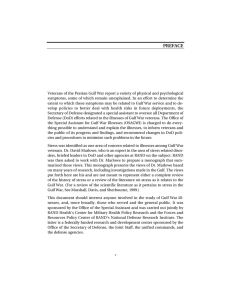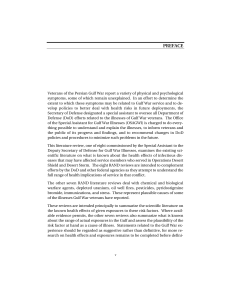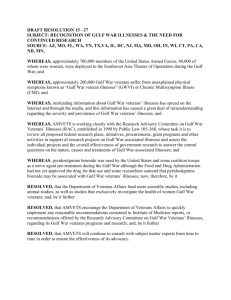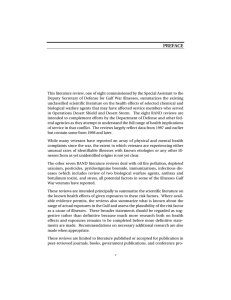UNIDENTIFIED INFECTIONS
advertisement
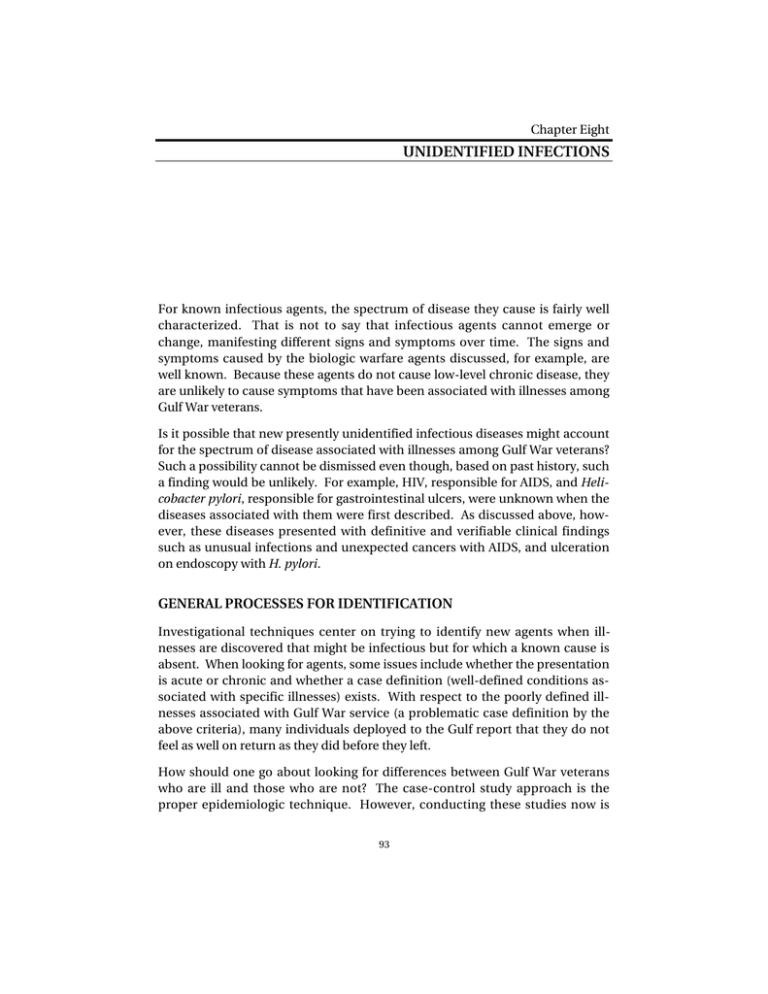
Chapter Eight UNIDENTIFIED INFECTIONS For known infectious agents, the spectrum of disease they cause is fairly well characterized. That is not to say that infectious agents cannot emerge or change, manifesting different signs and symptoms over time. The signs and symptoms caused by the biologic warfare agents discussed, for example, are well known. Because these agents do not cause low-level chronic disease, they are unlikely to cause symptoms that have been associated with illnesses among Gulf War veterans. Is it possible that new presently unidentified infectious diseases might account for the spectrum of disease associated with illnesses among Gulf War veterans? Such a possibility cannot be dismissed even though, based on past history, such a finding would be unlikely. For example, HIV, responsible for AIDS, and Helicobacter pylori, responsible for gastrointestinal ulcers, were unknown when the diseases associated with them were first described. As discussed above, however, these diseases presented with definitive and verifiable clinical findings such as unusual infections and unexpected cancers with AIDS, and ulceration on endoscopy with H. pylori. GENERAL PROCESSES FOR IDENTIFICATION Investigational techniques center on trying to identify new agents when illnesses are discovered that might be infectious but for which a known cause is absent. When looking for agents, some issues include whether the presentation is acute or chronic and whether a case definition (well-defined conditions associated with specific illnesses) exists. With respect to the poorly defined illnesses associated with Gulf War service (a problematic case definition by the above criteria), many individuals deployed to the Gulf report that they do not feel as well on return as they did before they left. How should one go about looking for differences between Gulf War veterans who are ill and those who are not? The case-control study approach is the proper epidemiologic technique. However, conducting these studies now is 93 94 Infectious Diseases difficult because patients have been out of service for almost a decade. Physicians and other scientists look for evidence of exposure to infectious agents by comparing levels of antibodies in the blood before an illness to levels after recovery. In a similar way, it might be possible to compare blood serum samples from veterans that were collected before deployment with samples drawn on these same individuals after their return. If the differences in these “pre-post” sample comparisons are significantly bigger in those deployed to the Persian Gulf than in those who were not, then an epidemiologic difference exists that might explain causality. To look for unknown agents, a number of relatively new approaches and techniques are being taken. REPRESENTATIONAL DIFFERENCE ANALYSIS (RDA) This technique amplifies the genetic information (DNA) present in specimens of patient’s tissues (in the case of illnesses among Gulf War veterans this would generally be blood—particularly white blood cells). Samples from patients with illnesses among Gulf War veterans and from those who do not have the illnesses are treated the same. Then investigators subtract the DNA that is common to both the patients and the healthy control volunteers. The remaining DNA must then be evaluated to determine its nature and whether it represents nuclear material from an unknown infectious agent. This technique was used to demonstrate the presence of herpes virus in samples of Kaposi’s sarcoma, a malignancy found in some AIDS patients (Relman, 1997; Fredericks and Relman, 1996; Lisitsyn, 1995; Baldocchi and Flaherty, 1997). SERIAL ANALYSIS OF GENOMIC EXPRESSION (SAGE) This method has properties similar to that of RDA. Using this technique, the characteristics of an organism are identified or determined by the genetic information that it expresses (Velculescu et al., 1995). This method allows researchers to look simultaneously at a large number of genetic messages and to quantify the genetic information identified. CDNA EXPRESSION ANALYSIS This is another genetic technique that looks for evidence that messenger RNA (mRNA) is present in a sample. mRNA is the nuclear material that takes genetic messages from the nucleus of the cell and tells the cell what proteins to make. The technique looks at genes that have been characterized. One then uses this technique to look for differences in the types of mRNA expressed by patients Unidentified Infections 95 and nonpatients. Once differences exist between patients and nonpatients, the differences may be characterized (Hayashi et al., 1995). The techniques discussed can be considered emerging approaches, but they have been useful in beginning to look for unexplained causes of illness. Presently, they are being evaluated to search for causes of chronic fatigue syndrome, illnesses among Gulf War veterans, and other conditions.
